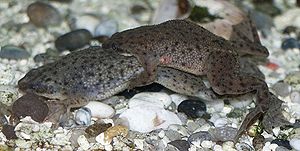Dwarf clawed frogs
| Dwarf clawed frogs | ||||||||||||
|---|---|---|---|---|---|---|---|---|---|---|---|---|

Böttger's dwarf-clawed frog ( H. boettgeri ) |
||||||||||||
| Systematics | ||||||||||||
|
||||||||||||
| Scientific name | ||||||||||||
| Hymenochirus | ||||||||||||
| Boulenger , 1896 |
The genus dwarf clawed frogs ( Hymenochirus ) belongs to the family of tongue-less frogs (Pipidae) within the order of the frogs . The four species to be distinguished have a length of only three to barely four centimeters and live in the Congo area and in Cameroon . You can find them in herb-rich rainforest waters of all kinds, where they lead a year-round aquatic way of life. They have a very flattened body, a small head and long-jointed fingers. These are quasi “mini versions” of the clawed frogs ( Xenopus ) - unlike these, however, the dwarf clawed frogs also have webbed front fingers, for example.
Little clawed frogs are often kept in aquariums.
Reproduction
Mating behavior is characterized by various peculiar rituals. In addition to constant, monotonous (“ticking”) calls, the males also perform a kind of “dance” with hasty, scratching movements of the feet and clasping rowing of the arms. If there is finally an amplexus with a female ready to mate, this clasping takes place in the lumbar region, as is common practice with the suborder Mesobatrachia . For the actual spawning, the couple swims to the surface of the water and turns so that the belly sides point upwards. After repeating this sequence of movements several times, the spawn is released and inseminated at the same time just above the water surface . Then the couple returns to the bottom of the water and pauses for a few minutes. Further spawning processes take place over several hours - a total of around 50 to over 300 (maximum proven: 364). The up to 1000 eggs remain in the surface membrane of the water level, but are sometimes also caused to sink by the movements of the couple. Such eggs usually do not develop.
Tadpoles
The tadpoles hatch after about one and a half to two days of embryonic development and after several days (approx. 6 days) of stationary adherence they move into the free-swimming phase of life. Now some peculiarities are revealed compared to other frog larvae: They regularly gasp for air on the surface (lung breathing!), Although they also have tiny outer gills. Their diet differs from that of other frogs because they have a carnivorous way of life in which they hunt animal plankton such as Cyclops or Artemia nauplii . For this purpose, Hymenochirus tadpoles have designed a specially shaped, upwardly directed “mouthpipe” with which they suck in the prey. The water absorbed with it escapes through the breathing holes (spiracula). Metamorphosis of the larvae usually takes place after 60 to 70 days .
Systematics
The following species belong to the genus of dwarf clawed frogs:
- Böttger's dwarf clawed frog ( Hymenochirus boettgeri ( Tornier , 1896) )
- Boulengers dwarf-clawed frog ( Hymenochirus boulengeri Witte , 1930 )
- Stocky dwarf clawed frog ( Hymenochirus curtipes Noble , 1924 )
- Hymenochirus feae Boulenger , 1906
literature
- Kriton Kunz: The dwarf clawed frog Hymenochirus boettgeri. Natur und Tier-Verlag, 2004, ISBN 3-937285-13-X .
- Kriton Kunz: Clawed frogs, dwarf clawed frogs, comb toads - Pipidae in nature and human hands. Natur und Tier-Verlag, 2003, ISBN 3-931587-75-4 .
- Werner von Filek: Frogs in the aquarium. Franckh-Kosmosm, Stuttgart 1981, ISBN 3-440-04981-7 .